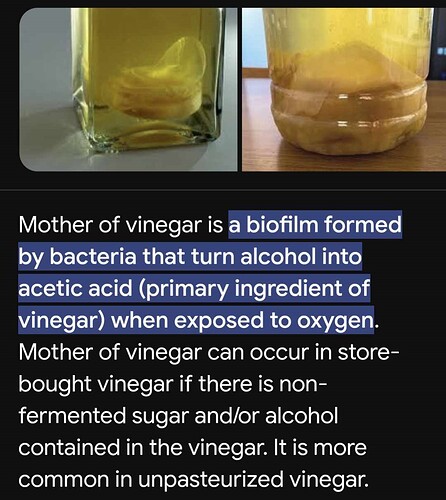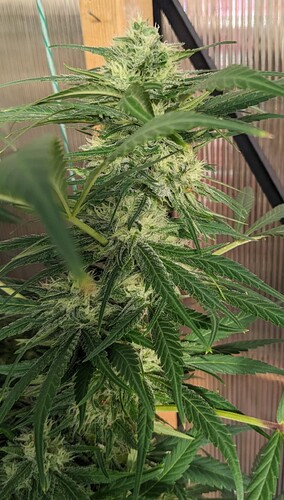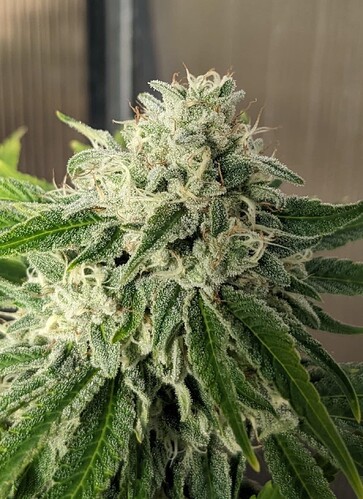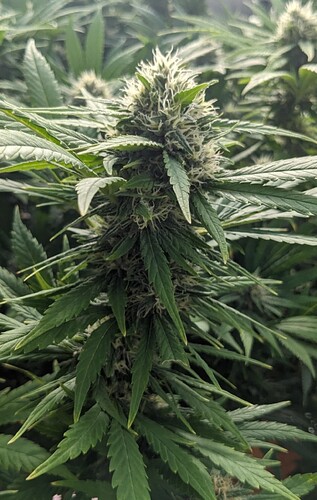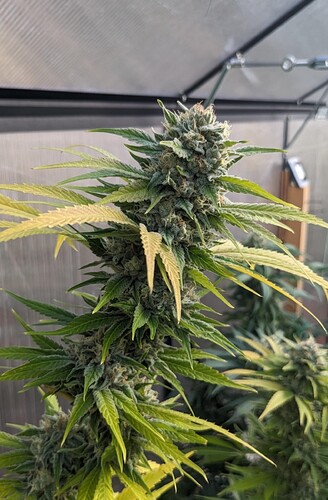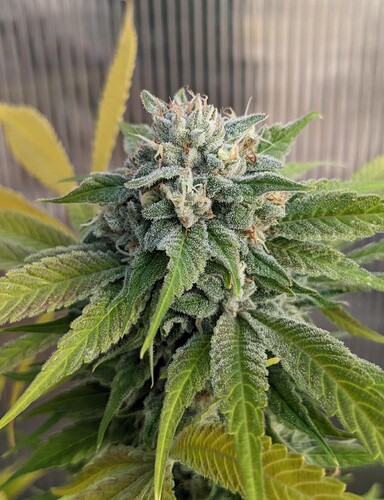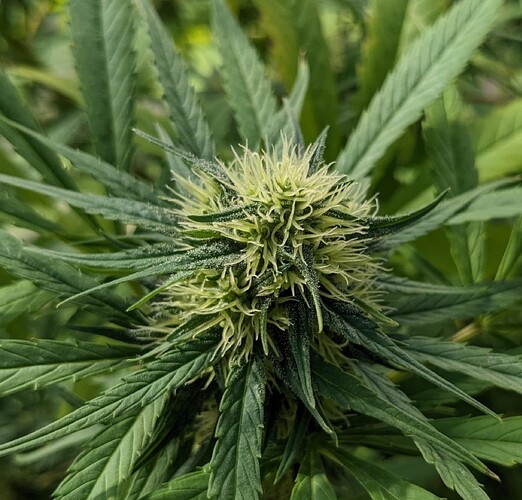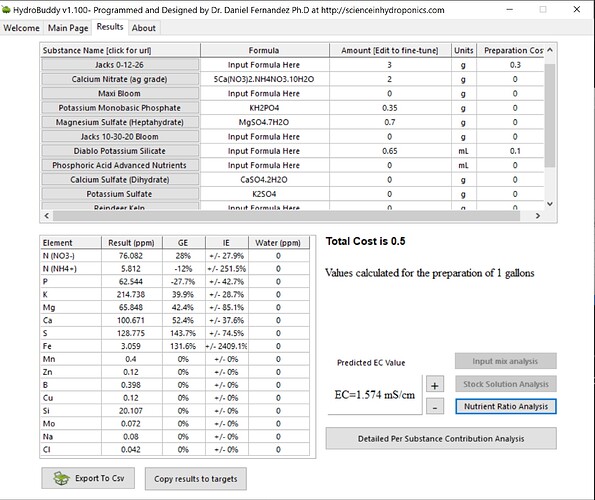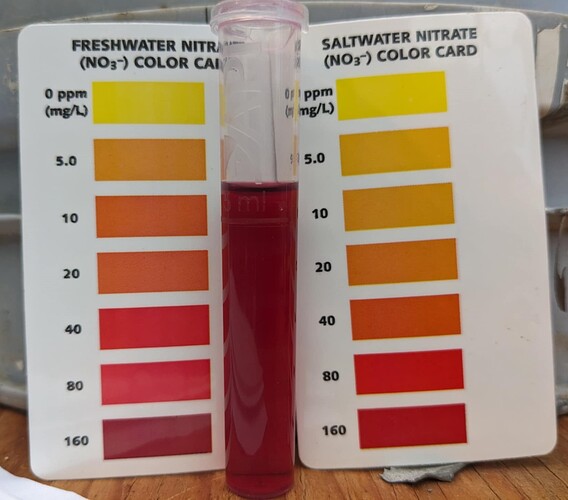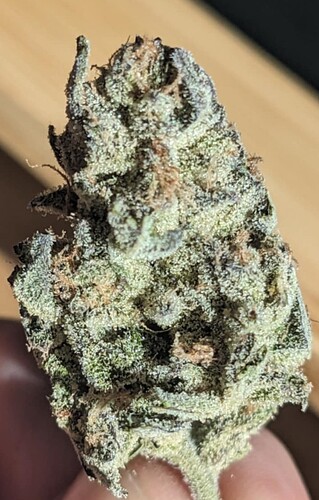Killer plant by the way. Currently running 707 OG Kush but not super impressed with it. Debating on running either Tony Greens GG4 RIL, or some sort of NL from either AK bean brain or Authentic Genetics.
Wish I still had that one for sure. Why not use gypsum for your calcium later on? Or do you make stock solutions? What do you use for micros? I’m thinking about getting some just to add for flush week. Still debating though if I should get adventurous here or just stick to plain water like I used to. Not sure what to leave in, hard to decipher all the online debate when I’m playing catch-up.
With my old bag of 5-12-26 and the new 0-12-26, I’ll have enough for a while, but after that I might try going from scratch. The 0-12-26 drops the PH way more than the 5-12-26, don’t need any PH down with it, even when using potassium silicate, kinda nice.
I use calcium acetate in transition as well. If it isn’t bacteria, it might just be haziness that doesn’t change the available nutrient levels. You said that plants respond positively to calcium acetate, so it wouldn’t be creating something like insoluble calcium sulfate.
Maybe the acetic acid in the calcium acetate is creating a mother of vinegar situation? I’ve heard of it happening with folks who use vinegar as PH down.
Hello @GrowStuff. I do make stock solutions but I haven’t used the solution grade gypsum in my mixes yet. Mostly because I heard it’s not completely soluble and my S levels are way above where I would like them.
Also, I use the chelated micro mix from custom hydro nutes.
Very informative article @AgTonik. I always figured it was some sort of bacteria buildup because the mix would be a brownish color but wouldn’t have an off odor or anything.
You called it. I got away with it, probably just barely, but the area I spot tested that got a “double spray” is showing some yellowing. I’d call it “veinal yellowing” rather than “interveinal”, it also brought on the “sawtooth” look. I’ll be careful to try not to hit the test area twice in the future. Kinda new to this foliar game. I just followed the Mr.Fulvic bottle, says 2.5ml/gal for foliar. The little tip burn was there before, was away for a few days while it got hot, didn’t lower the EC enough before I left, was up to 2.2 when I got home.
I bought some PowerSi to try for foliar, I heard some hype about more frost. They suggest even late in flower to foliar, if I’m understanding the chart properly. Does anybody do this? Website also says that you don’t need surfactant, is it not beneficial to add some polysorbate 80 or something? Maybe it has something already? Maybe I shouldn’t do it? Having fun trying stuff out though.
“completely lights off” I’ve been doing it right after the gavitas cool, turn off at 7:10pm, sunset today is 7:14pm, and some twighlight after. How would you spray lights on? With LEDs you can dim substantially?
If you are getting yellowing, you overdid it a bit. Just up your calcium nitrate for a feeding. I need to put it in the literature. I would start with 0.5ml per gallon and work up to 1ml per gallon if you are spraying regularly. The 2.5ml per gallon is for direct sun, 2-3x per season.
I think my sulphate levels are a little on the high side as well. Maybe you’ve seen it already but there’s some good info on using gypsum here:
Using calcium sulfate in hydroponics – Science in Hydroponics
Speaking on sulphate, I got some potassium sulphate, but it’s pink. I tried the re-crystalization process with it from one of Dr. DF’s youtube videos, but it still came out pink. Bought some from another source, was also pink. Oh well, I’m just using it to buff Jacks so not adding a lot.
I bought an aquarium nitrate test kit, goes from 5-160ppm. I don’t think it’s very accurate for hydroponics though, different salts must throw it off because it has a different colour chart for salt or fresh water aquariums. I mixed up a batch that should have 80ppm and it was reading more like 160ppm, deep red on the card. Checking a week old nutrient mix in the RDWC though, it was reading in the 5-10ppm range, pale yellow.
I know the plants take up the nitrate first and it gets depleted in recirculating systems. Can see this effect with the PH too, it goes up and up until the nitrate is used and then stabilizes, and this is when I get the 5-10ppm reading. I’ve tried both phosphoric and sulfuric for PH down, I’d rather have the extra P over S though so I use phosphoric. I’m curious now about using nitric acid to replace the nitrate in res, but I’m not sure if it’s ideal to try and maintain the nitrate ppm in a recirculation system, because ultimately the plants will take up much more N over their life while never having a very high ratio of N.
I only know of one PH down that uses nitric acid, technaflora. I believe it’s 5-10%. Are there other easily available PH down hydroponic brands that use nitric acid? I don’t think I can buy it from a lab supply, or what the dilution limit is, but it appears to be a controlled substance.
Greenhouse is doing okay, not my best work but I’ll cut myself some slack, it’s far from a perfect setup, and I’ve been experimenting. The dehumidifier was keeping things pretty toasty all night, around 18C, but then it got just cold enough that it started to ice up and cycle, and once that happened it just creates a feedback loop that ices it up more. Had a couple nights of 9C before I got the heater going. The Mexican bagseed didn’t like that much, got some yellowing on it even though it’s nowhere near ripe. Got some fall colours coming out on the Gorilla G Lemon. Letting them flower naturally like this really has me at different stages, going to set up a flush res pretty quick here to switch them onto as they finish while keeping the others fed.
Cherry Lemonade #2 is smelling really nice even though it’s more immature, CL#1 is pretty flat and boring. The GGLs are all very stinky, not much lemon though. Mbag smells super sweet, took two weeks longer than everything to start flowering though and it’s looking like it wants to take it’s time finishing as well.
Hello @GrowStuff. I have read that article before. I’ve been thinking about supplementing solution grade gypsum when I start cutting Ca No3 around week 3 but have yet to do so. I’m in the process of cooking some soil for my next run because I’m honestly just tired of effing with salts for the time being. Your plants look fantastic! Are you feeding standard 3-2-1?
Thanks @SeymourGreen. I think they look pretty decent too, just messed up my yield a bit with the potassium deficiency I got from adding too much calcium without compensating. My plan to use that nutrient schedule is out the window, cause everything is at such different stages. After transition I trailed off on the 5-12-26 and have been giving 3-2-0.7, with 0-12-26, MKP, potassium silicate, and Mr. Fulvic.
A better understanding of N usage in an RDWC has me hypothesizing that in a recirculating system the total amount of N is more important than the ratios. I maybe had too much total N when I tried jacks in the past for flowering, because my reservoir size was much larger per plant, so there was a large amount of N available regardless of the ppm concentration. Now that I have these monster 4 month+ old plants that are completely rootbound in a much smaller overall reservoir, I’m seeing this nitrogen depletion thing where my PH stabilizes when there’s nothing left to take up, and the aquarium nitrate test is confirming there’s no more nitrate available. Compounding this is likely the CL#1 girl who looks like a greedy little nitrogen hog giving herself the claw and much deeper green than the other girls. Happens to also be the most leafy and least stinky.
Idk if this helps, but it seems marginally relevant. I didnt know until I read that link that dissolved oxygen affects ph readings. I was trying to build hydro systems at the time that maximized dissolved oxygen in the root zone, so it helped me.
Interesting, I was thinking of doing something similar when I build a proper setup. I’m already running air nanobubbles, which helps a lot in RDWC, keeps everything a lot cleaner and you can get away with some organics like kelp and fulvic. Once I have a CO2 tank going I was thinking of nanobubbling it through the water to see what happens. Apparently CO2 nanobubbles are good for plant growth, since they can be taken up directly maybe it’s a way to “cheat” on the carbon content in hydroponics that I’ve heard touted as responsible for the supposed higher quality of organic buds.
I need to get a DO meter. Planning on an Arduino setup to monitor everything though so might as well just focus on that and get a probe for the Arduino instead.
Got one of the GGLs on the flush now. Just going plain rain water, old school. Took a bud off before the flush to see what it’s like. Pretty sure I’ve done this before but I don’t have a full recollection of the results. I write secrets in my journal though now so I won’t forget this time.
Did another water change, used the nitrate test kit, again, pretty much all nitrate is gone on the week old res water. Mixed up a fresh batch of 70ppm nitrate, reads like 160ppm on the card so it’s not accurate, but good enough I think to tell when you’re “out” of nitrate. Still a bit perplexed as to the best way to deal with this, using nitric acid to replenish it sounds like it makes sense, but I’m not sure if the extra overall nitrate would be a good idea.
The nitrate gets depleted like this even though there’s a 55 gallon barrel filled with the same solution feeding into the system through a float valve as the plants drink.
Eventually I’ll have a enough good questions written for an hour or two or consultation.
Just puffed some of this GMO OG auto from the greenhouse, had a possible big brain idea. Maybe I can gradually dilute my nutrient mix to known ppms of nitrate and run nitrate tests to develop my own colour scale that would be accurate?
Is that gmo from atlas seed company? I have one going right now that I am trying to cross with Fugue State.
Idk the answer to your question, but it reminds me of growing veg plants in aquaponics. The fish, the bacteria and the plants produce and cycle out the nitrates.
Yeah it’s from Atlas. I like it.
Just realized I was confounding nitrate and elemental N. The kit measures ppm in nitrate, so I think I divide by 4.427 to get elemental N. The kit therefore only measures to 36ppm N, which is likely why it’s pegged at dark red with a fresh 70ppm N nutrient mix. This however, means the pale orange colour is even lower on elemental N than I thought.
